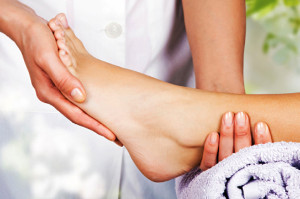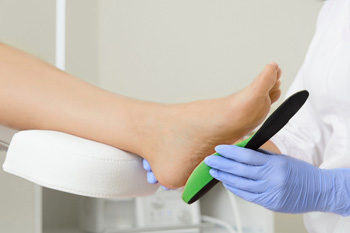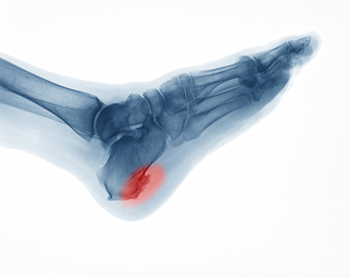
Suffering from a broken ankle is an unfortunate reality that some individuals might have to face at some point in their lives. Broken, or fractured, ankles occur when a person twists or rolls their ankle joint, putting their weight on the ankle in an awkward way that leads to injury. Broken ankles can also occur after a heavy object is dropped on the ankle. If you have a broken ankle, you might experience a range of symptoms from pain and swelling at the affected joint to bruising and tenderness. In less serious instances, broken ankles may be treated with braces or casts. In more severe cases, broken ankles can be treated with surgical procedures. Recovery time for a broken ankle varies according to the specific case. Generally speaking, recovery can take anywhere from six to 12 weeks, and possibly longer. When individuals are recovering from this kind of injury, they typically can not put weight on their feet, and must therefore use a mobility device such as crutches. If you have a broken or fractured ankle, it is imperative that you contact a podiatrist who can help you address the problem.
Broken ankles need immediate treatment. If you are seeking treatment, contact one of our podiatrists from McKinney Podiatric Associates, PA. Our doctors can provide the care you need to keep you pain-free and on your feet.
Broken Ankles
A broken ankle is experienced when a person fractures their tibia or fibula in the lower leg and ankle area. Both of these bones are attached at the bottom of the leg and combine to form what we know to be our ankle.
When a physician is referring to a break of the ankle, he or she is usually referring to a break in the area where the tibia and fibula are joined to create our ankle joint. Ankles are more prone to fractures because the ankle is an area that suffers a lot of pressure and stress. There are some obvious signs when a person experiences a fractured ankle, and the following symptoms may be present.
Symptoms of a Fractured Ankle
If you suspect an ankle fracture, it is recommended to seek treatment as soon as possible. The sooner you have your podiatrist diagnose the fracture, the quicker you’ll be on the way towards recovery.
If you have any questions, please feel free to contact one of our offices located in Pasadena, Baytown, League City, Houston, and Pearland,TX . We offer the newest diagnostic and treatment technologies for all your foot care needs.

Foot massages are a common form of relaxation, and many people choose this type of foot therapy to find relief from aching feet. It may come from standing all day or from wearing shoes that do not fit correctly. An additional method of therapy is reflexology and there are differences between the two. Reflexology is practiced by applying pressure to specific areas of the foot which can stimulate the central nervous system and can positively affect energy pathways. Different organs in the body are linked to pressure points on the feet and may have healing effects. Getting a foot massage involves massaging the entire foot without centering on certain areas. Some of the health benefits from either form of foot therapy can consist of improved circulation, relaxation, stress relief, and reduced muscle tension. Some patients find relief from headaches and back pain and can enjoy an overall sense of well-being. If you are interested in learning more about the benefits of different types of foot therapy, it is suggested that you consult with a podiatrist who can answer any questions you may have.
Foot therapy is often necessary for those recovering from either foot deformities or foot injuries. If you have concerns regarding therapy, consult with one of our podiatrists from McKinney Podiatric Associates, PA. Our doctors can provide the care you need to keep you pain-free and on your feet.
Most Common Injuries
People who are active or athletes are prone to a variety of injuries. Therefore, it is often important to take part in physical therapy in order to quickly get back on the right track.
What to Do When Injured
Physical Therapy – This specialized treatment will focus on the affected area, speeding up recovery and the overall healing process. It is a proven method that has helped millions of people return from any injury.
During physical therapy you will undergo regimented training to get back into full form. Training is often very difficult, especially at first when the foot feels weak. Physical therapy often involves:
Basic stretching and twisting exercises – getting the feet’s mobility and flexibility up.
Massaging – the therapist will massage the injured area in order to activate the muscles and relax them.
Strengthening Exercises – this allows the muscles in the affected area to regain their full strength, a vital step towards full recovery.
If you have any questions please feel free to contact one of our offices located in Pasadena, Baytown, League City, Houston, and Pearland,TX . We offer the newest diagnostic tools and technology to treat your foot and ankle needs.

With any sport, there is risk of injury while training or playing. This is true for American football as well. The four most common foot injuries among football players are an Achilles tendon rupture, turf toe, a Jones fracture, and plantar fasciitis. An Achilles rupture often happens to football players who train intensively after a period of inactivity, such as at the start of a new season. Achilles tendonitis is inflammation of the tendon located at the back of the foot above the heel, but a rupture is more serious and involves a partial or complete tear. Turf toe is a sprain of the big toe joint. Football players are continually pushing off the ground from the toes, and overextension of the big toe joint can result. This is especially common when playing on artificial turf because of its gripping nature. A Jones fracture is also called a 5th metatarsal fracture. The 5th metatarsal is the long bone that runs on the outside of the foot that connects to the baby toe. It can break from sudden impact, a poor landing, repeated stress, or overuse. This injury can recur if not healed properly. The stud or cleat under a football boot can cause swelling of the tissue that runs under the foot, known as plantar fasciitis. These injuries might be prevented by warming up well, increasing training slowly, wearing supportive football boots, and possibly adding sports inserts. If you or your loved one plays football and has sustained a foot injury, see a podiatrist who can offer a proper diagnosis and treatment options.
Ankle and foot injuries are common among athletes and in many sports. They can be caused by several problems and may be potentially serious. If you are feeling pain or think you were injured in a sporting event or when exercising, consult with one of our podiatrists from McKinney Podiatric Associates, PA. Our doctors will assess your condition and provide you with quality foot and ankle treatment.
Common Injuries
The most common injuries that occur in sporting activities include:
Symptoms
Symptoms vary depending upon the injury and in some cases, there may be no symptoms at all. However, in most cases, some form of symptom is experienced. Pain, aching, burning, bruising, tenderness, tightness or stiffness, sensation loss, difficulty moving, and swelling are the most common symptoms.
Treatment
Just as symptoms vary depending upon the injury, so do treatment options. A common treatment method is known as the RICE method. This method involves rest, applying ice, compression and elevating the afflicted foot or ankle. If the injury appears to be more serious, surgery might be required, such as arthroscopic or reconstructive surgery. Lastly, rehabilitation or therapy might be needed to gain full functionality in the afflicted area. Any discomfort experienced by an athlete must be evaluated by a licensed, reputable medical professional.
If you have any questions, please feel free to contact one of our offices located in Pasadena, Baytown, League City, Houston, and Pearland,TX . We offer the newest diagnostic and treatment technologies for all your foot care needs.

Many people need to wear orthotics in their shoes. They are defined as custom-made insoles that can help a variety of foot conditions and may also be used to improve ankle support. A proper diagnosis can determine if orthotics are right for you. This can consist of having a physical examination performed on the feet, discussing existing symptoms, and checking for painful deformities. Additionally, an X-ray or MRI may be ordered that can show any signs of arthritis or damage to the foot. There are some foot conditions that can alter the foot structure including bunions, hammertoes, heel spurs, or flat feet. There are two categories of orthotics consisting of rigid and flexible and may be available in two sizes, full-shoe inserts or smaller inserts that the heels can fit in. If you have a foot ailment and would like more information about the benefits of wearing custom-made orthotics, it is strongly advised that you seek the counsel of a podiatrist.
If you are having discomfort in your feet and would like to try orthotics, contact one of our podiatrists from McKinney Podiatric Associates, PA. Our doctors can provide the care you need to keep you pain-free and on your feet.
What Are Orthotics?
Orthotics are inserts you can place into your shoes to help with a variety of foot problems such as flat feet or foot pain. Orthotics provide relief and comfort for minor foot and heel pain but can’t correct serious biomechanical problems in your feet.
Over-the-Counter Inserts
Orthotics come in a wide variety of over-the-counter inserts that are used to treat foot pain, heel pain, and minor problems. For example, arch supports can be inserted into your shoes to help correct overarched or flat feet, while gel insoles are often used because they provide comfort and relief from foot and heel pain by alleviating pressure.
Prescription Orthotics
If over-the-counter inserts don’t work for you or if you have a more severe foot concern, it is possible to have your podiatrist prescribe custom orthotics. These high-quality inserts are designed to treat problems such as abnormal motion, plantar fasciitis, and severe forms of heel pain. They can even be used to help patients suffering from diabetes by treating foot ulcers and painful calluses and are usually molded to your feet individually, which allows them to provide full support and comfort.
If you are experiencing minor to severe foot or heel pain, it’s recommended to speak with your podiatrist about the possibilities of using orthotics. A podiatrist can determine which type of orthotic is right for you and allow you to take the first steps towards being pain-free.
If you have any questions please contact one of our offices located in Pasadena, Baytown, League City, Houston, and Pearland,TX . We offer the newest diagnostic and treatment technologies for all your foot and ankle needs.

Heel spurs are bony outgrowths of calcium deposits that grow underneath your heel. Because they can potentially cause you discomfort and pain, it is important to know their symptoms. The heel spur grows toward the arch of the foot. In some cases, heel spurs can cause pain. Other patients with heel spurs, however, might not experience any pain. If you have heel spurs, you might exhibit inflammation in the foot or even swollen heels. Some patients with heel spurs may notice that the affected foot and area become hot to the touch. It is important to note that not all individuals with heel spurs can see the bony spur. Therefore, some patients with heel spurs might only be able to confirm their condition after undergoing an X-ray scan to examine the heel area. Of course, every individual is different, and not every person’s symptoms are the same. Regardless of what having heel spurs might feel like for you, you might be able to avoid the development of heel spurs by wearing supportive and well-fitting footwear. If you think that you might have heel spurs, see a podiatrist who can help.
Heel spurs can be incredibly painful and sometimes may make you unable to participate in physical activities. To get medical care for your heel spurs, contact one of our podiatrists from McKinney Podiatric Associates, PA. Our doctors will do everything possible to treat your condition.
Heels Spurs
Heel spurs are formed by calcium deposits on the back of the foot where the heel is. This can also be caused by small fragments of bone breaking off one section of the foot, attaching onto the back of the foot. Heel spurs can also be bone growth on the back of the foot and may grow in the direction of the arch of the foot.
Older individuals usually suffer from heel spurs and pain sometimes intensifies with age. One of the main condition's spurs are related to is plantar fasciitis.
Pain
The pain associated with spurs is often because of weight placed on the feet. When someone is walking, their entire weight is concentrated on the feet. Bone spurs then have the tendency to affect other bones and tissues around the foot. As the pain continues, the feet will become tender and sensitive over time.
Treatments
There are many ways to treat heel spurs. If one is suffering from heel spurs in conjunction with pain, there are several methods for healing. Medication, surgery, and herbal care are some options.
If you have any questions feel free to contact one of our offices located in Pasadena, Baytown, League City, Houston, and Pearland,TX . We offer the latest in diagnostic and treatment technology to meet your needs.